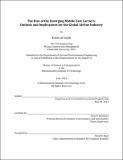The rise of the emerging Middle East carriers : outlook and implications for the global airline industry
Author(s)
Al-Sayeh, Karim Marwan
DownloadFull printable version (2.544Mb)
Other Contributors
Massachusetts Institute of Technology. Department of Civil and Environmental Engineering.
Advisor
Peter P. Belobaba.
Terms of use
Metadata
Show full item recordAbstract
The development of the aviation industry in the Middle East over the past decade has captivated both industry watchers and passengers alike. The interest in the Middle East aviation industry is due to the fact that it has produced a new type of airline - the Emerging Carrier, specifically Emirates, Etihad Airways, Qatar Airways and Turkish Airlines. These Emerging Carriers have expanded rapidly over the past decade, frequently disrupting the status quo in aviation markets. This thesis analyzes the growth of the Emerging Carriers over the past 10 years, across major inter-regional travel markets. Airline schedule data is used to determine how these markets have grown during that time, as well as how the Emerging Carriers have contributed to that growth. A forecast of the potential deployable capacity of each of the Emerging Carriers in 2020 is developed, in order to evaluate the implications of their continued rapid growth. This forecast is evaluated against industry forecasts in order to assess the viability of their growth plans through the end of the decade. By 2013, the four Emerging Carriers collectively accounted for over 50% of the available capacity from the Middle East to Europe, Asia, North America and Africa. They currently have over 600 aircraft on order, the majority of which are widebody aircraft. By the end of the decade their fleets are forecasted to double in size, which would rank all four of them among the world's 20 largest airlines. The forecast developed in the thesis projects that they will account for over 90% of the capacity in several major inter-regional travel markets to and from the Middle East. Their rapid expansion over the past decade was due to both an increase in demand for air travel, and a diversion of passengers from other carriers. Our projections indicate that their planned growth through the end of this decade may outpace the increase in demand, thereby resulting in an overabundance of capacity.
Description
Thesis: S.M. in Transportation, Massachusetts Institute of Technology, Department of Civil and Environmental Engineering, 2014. This electronic version was submitted by the student author. The certified thesis is available in the Institute Archives and Special Collections. Cataloged from student-submitted PDF version of thesis. Includes bibliographical references (pages 160-167).
Date issued
2014Department
Massachusetts Institute of Technology. Department of Civil and Environmental EngineeringPublisher
Massachusetts Institute of Technology
Keywords
Civil and Environmental Engineering.